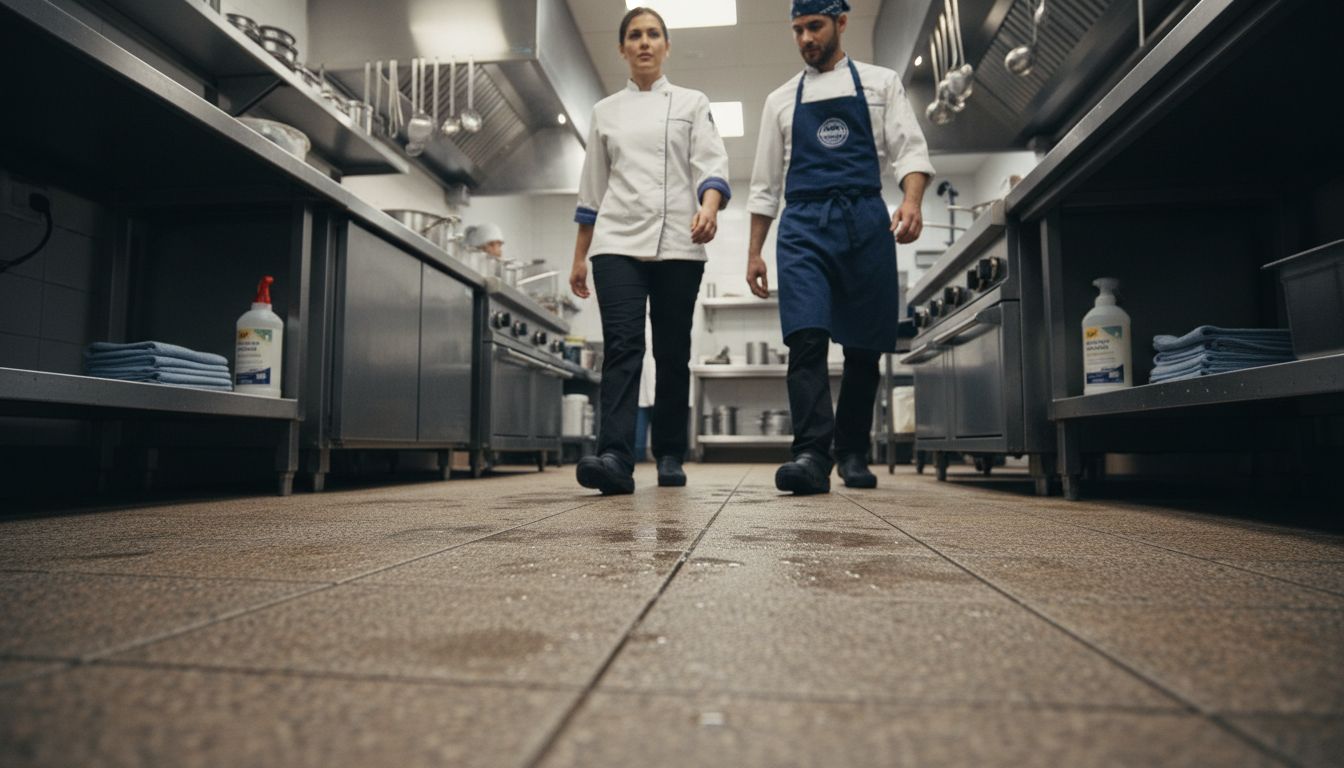
Complete Guide to Why Use Anti-Slip Tiles
Share
Every year, over 30 percent of workplace accidents in the UK are caused by slips and falls. This staggering number highlights how flooring choices can directly impact your daily safety, whether at work or home. Understanding how anti-slip tiles protect against hazards gives you the power to create safer, more reliable spaces. Learn how these specialised surfaces go beyond standard tiles by delivering strong grip and reliable protection under wet or oily conditions.
Table of Contents
- What Are Anti-Slip Tiles and How They Work
- Types of Anti-Slip Tiles for Different Spaces
- Key Features and Performance Standards
- UK Building Regulations and Safety Compliance
- Risks of Slippery Floors and Common Alternatives
- Cost Factors and Common Mistakes to Avoid
Key Takeaways
| Point | Details |
|---|---|
| Anti-slip Tiles Enhance Safety | Designed with specialized textures and materials to reduce slips in hazardous environments, these tiles are crucial for safety in commercial and residential spaces. |
| Performance Compliance is Essential | Adhering to workplace safety regulations is vital; anti-slip tiles must meet specific performance metrics to prevent legal repercussions. |
| Selecting the Right Tile is Critical | Professionals should prioritize slip resistance over aesthetic appeal to avoid long-term costs associated with workplace injuries and compliance failures. |
| Cost Factors Must Include Lifecycle | Initial installation costs can be misleading; consider maintenance and replacement expenses for a more comprehensive understanding of overall cost. |
What Are Anti-Slip Tiles and How They Work
Anti-slip tiles are specialised flooring solutions engineered to prevent accidental slips and falls in potentially hazardous environments. According to the Health and Safety Executive (HSE), these tiles are designed to maintain critical traction even in wet, greasy, or contaminated conditions.
The core mechanism behind anti-slip tiles involves creating surface textures and incorporating materials that significantly increase friction. These tiles typically feature microscopic ridges, raised patterns, or embedded gritty compounds that grip footwear and create resistance against sliding.
 By interrupting smooth surface contact, they disrupt potential slip scenarios before they can occur.
By interrupting smooth surface contact, they disrupt potential slip scenarios before they can occur.
Key characteristics of anti-slip tiles include:
-
Enhanced surface roughness
-
Special ceramic or stone compositions
-
Textured finishes that trap water and prevent hydroplaning
-
Chemical treatments that improve grip performance
While standard smooth tiles can become dangerously slippery, anti-slip tile solutions from Vivido provide strategic traction across multiple environments including bathrooms, commercial kitchens, swimming pool areas, and external walkways. Their innovative design transforms potential hazard zones into safer, more secure spaces.
Types of Anti-Slip Tiles for Different Spaces
According to the UK Slip Resistance Group, anti-slip tiles come in multiple varieties tailored to specific environments. Unglazed tiles are particularly effective for domestic and industrial settings, offering superior slip resistance due to their inherent surface texture.
Porcelain tiles stand out as a versatile anti-slip solution, delivering exceptional durability and low water absorption. These tiles are engineered to provide robust traction in both internal and external spaces, making them ideal for high-moisture areas like bathrooms, kitchens, swimming pool surrounds, and outdoor walkways.
Key types of anti-slip tiles include:
Here’s a comparison of common types of anti-slip tiles and their best-use environments:
| Tile Type | Key Features | Ideal Environments |
|---|---|---|
| Unglazed Ceramic | Rough surface High slip resistance |
Domestic kitchens Factories |
| Textured Porcelain | Durable Low water absorption |
Bathrooms Outdoor walkways |
| Mosaic | Intricate surface patterns | Shower areas Swimming pools |
| Stone-Look | Natural texture Slip resistance |
Garden paths Pool surrounds |
- Ceramic unglazed tiles with rough surface profiles
- Textured porcelain tiles with enhanced grip
- Mosaic tiles with intricate surface patterns
- Stone-look tiles with natural slip-resistant characteristics
When selecting anti-slip tiles, professionals often consider factors like surface roughness, water resistance, and intended usage. Explore tile design tips for stunning spaces to understand how different tile textures can dramatically improve both safety and aesthetic appeal across various environments.
Key Features and Performance Standards
According to the Health and Safety Executive (HSE), workplace flooring standards are critical for preventing slip-related accidents. The Workplace (Health, Safety and Welfare) Regulations 1992 mandate that floors must be suitable for specific work activities, maintained in good condition, and designed to allow safe movement even in potentially contaminated environments.
Performance standards for anti-slip tiles are typically measured through specific metrics that assess surface friction and traction. These include coefficient of friction tests, which evaluate how effectively a tile’s surface prevents sliding under different conditions such as wet, dry, or greasy environments. Professional testing organisations use specialised equipment to simulate real-world scenarios and rate tiles based on their slip resistance capabilities.
Key performance features of high-quality anti-slip tiles include:
- Consistent surface friction across different moisture levels
- Resistance to wear and degradation
- Ability to maintain grip under various contamination conditions
- Durability in high-traffic areas
- Compliance with safety regulations
Explore our comprehensive tile design tips to understand how selecting the right tile can dramatically improve both safety and aesthetic appeal in different environments.
UK Building Regulations and Safety Compliance
The Workplace (Health, Safety and Welfare) Regulations 1992 establish comprehensive safety standards for flooring in commercial and public spaces. According to the Health and Safety Executive (HSE), these regulations mandate that floors must be intrinsically safe, suitable for their intended use, and maintained to prevent potential slip hazards.
A critical aspect of compliance involves selecting appropriate flooring materials that demonstrate consistent slip resistance. The HSE case studies highlight significant legal and financial consequences for businesses that neglect these standards. For instance, a supermarket was prosecuted for installing floor tiles known to pose slip risks, underscoring the importance of proactive safety selection in tile specification and installation.
Key regulatory compliance requirements for anti-slip tiles include:
- Meeting minimum coefficient of friction standards
- Demonstrating consistent performance under varied environmental conditions
- Maintaining slip resistance throughout the tile’s operational lifecycle
- Providing clear documentation of material testing and performance
- Ensuring suitability for specific workplace environments
Explore our comprehensive tile design tips to understand how selecting the right tiles can help you meet stringent safety regulations while maintaining aesthetic appeal.
Risks of Slippery Floors and Common Alternatives
According to the Health and Safety Executive (HSE), slippery floors represent a significant workplace hazard, particularly in industries like food and drink where wet and contaminated surfaces are common. Slips and trips account for a substantial proportion of workplace injuries, with most accidents occurring on surfaces that lack adequate traction and surface roughness.
Alternative flooring solutions range from temporary measures to permanent installations. Some businesses initially attempt to mitigate slip risks through interventions like applying anti-slip coatings, using floor mats, or implementing strict cleaning protocols. However, these temporary solutions often prove less effective and more costly in the long term compared to purpose-designed anti-slip tiles.
Common risks associated with slippery floors include:
- Workplace injuries and potential compensation claims
- Reduced employee productivity
- Potential long-term health impacts for workers
- Increased insurance premiums
- Potential legal non-compliance penalties
Discover which tile finish works best for your space to understand how strategic tile selection can dramatically reduce slip-related risks and enhance overall safety.
Cost Factors and Common Mistakes to Avoid
According to the Health and Safety Executive (HSE), businesses often underestimate the total financial impact of inappropriate flooring choices. While initial tile installation might seem cost-effective, selecting low-quality or unsuitable tiles can lead to substantial long-term expenses, including potential legal fines, increased insurance premiums, and workplace injury compensation claims.
One critical mistake many organisations make is prioritising aesthetic appeal over functional safety. Cost-effective slip resistance involves more than just the initial purchase price. Professional insights suggest considering lifecycle costs, including maintenance, durability, and potential replacement expenses. A slightly more expensive tile with superior slip-resistant properties can ultimately save significant money by reducing accident risks and minimising long-term repair or replacement needs.
Common costly mistakes to avoid include:
- Choosing tiles based solely on visual appearance
- Neglecting professional slip resistance testing
- Failing to consider environmental conditions
- Overlooking ongoing maintenance requirements
- Ignoring manufacturer-recommended installation techniques
Discover which tile finish works best for your space to understand how strategic tile selection can balance aesthetic requirements with critical safety considerations.
Ensure Safety and Style with Expert Anti-Slip Tile Solutions
Slippery floors create real risks that can lead to costly accidents and workplace injuries. The article highlights essential factors like slip resistance, surface friction, and compliance with UK safety regulations that protect your space from hazards. Achieving this balance between safety and style need not be difficult or expensive. Choosing the right anti-slip tiles can transform hazardous areas into secure, attractive environments that inspire confidence.

Discover high-quality tile options tailored to meet your specific safety needs at Vividotiles. From textured porcelain to unglazed ceramics, explore how optimal design features significantly reduce slip risks without compromising on design. Take action today and visit our site to secure your premises with durable, compliant, and stylish anti-slip tiles — because preventing slips is invaluable. Learn more about how to select the perfect tile by reading our insightful tile design tips and find out which tile finish works best for your space. Start your safer flooring project now at Vividotiles homepage.
Frequently Asked Questions
What are anti-slip tiles?
Anti-slip tiles are specially designed flooring solutions that enhance traction and prevent slips and falls, particularly in wet, greasy, or contaminated environments. They feature surface textures and materials that increase friction, making them safer than standard smooth tiles.
How do anti-slip tiles work?
Anti-slip tiles create surface textures, such as microscopic ridges or raised patterns, that grip footwear and provide resistance against sliding. This interruption of smooth surface contact helps maintain safety in potentially hazardous areas.
What types of environments are best suited for anti-slip tiles?
Anti-slip tiles are ideal for various environments including bathrooms, commercial kitchens, swimming pool areas, and external walkways. They effectively improve safety in any area prone to moisture or contamination.
What should I consider when selecting anti-slip tiles?
When choosing anti-slip tiles, consider the tile’s surface roughness, water resistance, intended use, and compliance with safety standards. It’s important to select tiles that meet specific performance metrics for slip resistance to ensure safety and durability.
Recommended
- Anti‑Slip Tile Ceramic, Natural Stone & Outdoor Tiles – Vivido Tiles
- Tile Design Tips / 7 Top tips for Stunning Spaces - Vivido Tiles
- Tile Design Tips / 7 Top tips for Stunning Spaces - Vivido Tiles
- Polished or Matt Tile? : Which Finish Is Best for Every Room – Vivido Tiles
- Baby Gates for Tile Kitchens: Moisture-Resistant Narrow Solutions | Baby Safety Gates